2017 Giving Metrics Report
One of our goals here at ACE is to influence donations to highly effective animal charities. Over the last couple of years we have implemented systems to help us track these donations, as well as to survey donors who have indicated that they donated to our recommended charities as a result of ACE’s guidance1. In this report, we will detail what we know about the donations and donors that were influenced by ACE’s 2017 charity recommendations. We will also evaluate the impact that ACE has had on donors and on the effective animal advocacy movement as a whole.
Definitions
- “Top Charities” refers to the animal charities that we believe work most effectively on behalf of animals.
- “Standout Charities” refers to the animal charities that we feel are highly effective and showing promising progress in their efforts on behalf of animals.
- “Recommended Charities” refers to both Top and Standout Charities.
- “Recommended Charity Fund” or “RCF” refers to ACE’s Fund that was launched on November 27, 2017 to support ACE’s recommended charities in accordance with our research team’s recommended allocation. Although grants from this Fund were distributed in January 2018, we are including them in this report because the donations for that grant period were made in 2017.
How We Track Money Moved
Midway through 2015, we started collecting donations on behalf of our Top Charities. This has helped us a great deal in learning how donors use our recommendations. In 2017, donations through ACE accounted for almost 26% of the total amount of donations that ACE influenced to our recommended charities (an increase from 9% in 2016). The remaining 74% of donations were reported to us by those charities or by donors themselves.
Twice per year, we ask our Top Charities to report to us on the amount of donations they’ve received that they know were influenced by ACE. As a condition of being an ACE Top Charity, we ask them to establish a tracking system to help both us and them understand the impact of their recommendation. Each charity tracks this differently; some use checkboxes on their donation forms, while others add flags to their donors’ records when they mention ACE in follow-up correspondence. We think they report the donations that they know were influenced by ACE with a high level of accuracy, though there may be additional donations influenced by ACE that they do not know about because some donors may not indicate ACE’s influence on their decision to give. In 2017, we started reaching out to our Standout Charities to ask if they knew which of their donations were influenced by ACE. We have also had an increasing number of donors who report to us directly about the giving they did as a result of ACE’s charity recommendations.2
Recommended Charities
Money Moved to Recommended Charities By Year
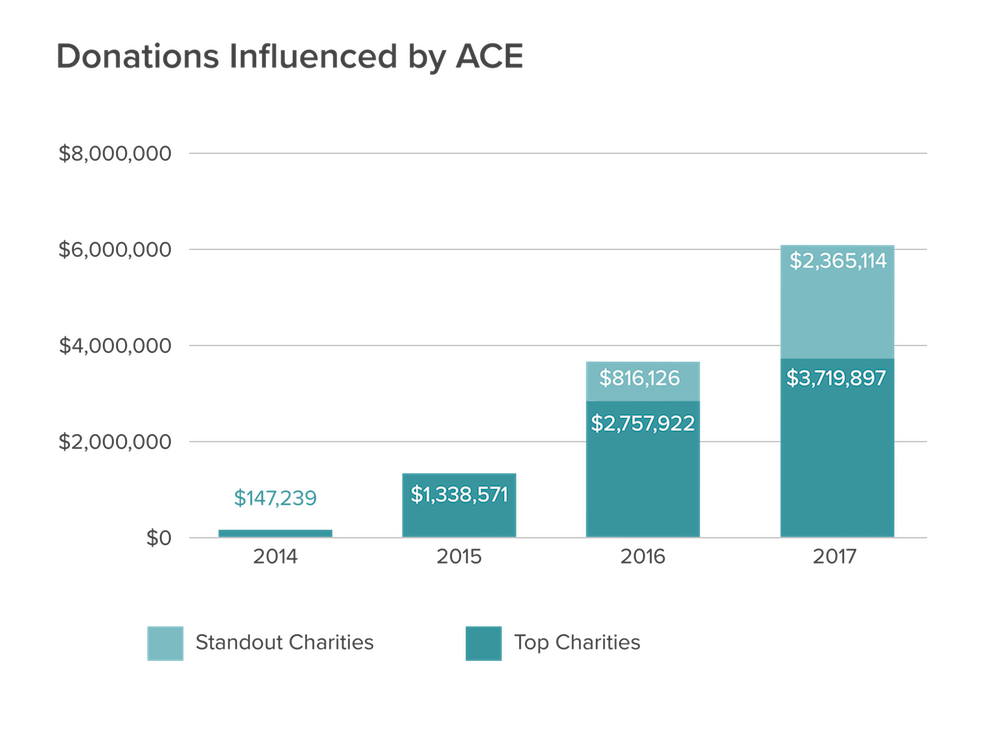
Money Moved by Charity
In 2017, our Top Charities received $3,719,897 and our Standout Charities received $2,365,114 in ACE-influenced donations. This means that we influenced $6,085,011 to recommended charities in 2017, with 61% going to Top Charities and 39% going to Standout Charities. The average gift that ACE influenced to our recommended charities was $764.
| ACE Top Charities | Donated through ACE | Donated through ACE’s RCF | Donated Directly to Charity | Total |
| The Humane League | $103,076.02 | $227,132.23 | $1,112,167.22 | $1,442,375.47 |
| The Good Food Institute | $84,606.44 | $321,770.65 | $655,624.48 | $1,062,001.57 |
| Mercy For Animals* | $71,326.67 | $0 | $606,696,36 | $678,023.03 |
| Animal Equality** | $10,394.48 | $397,481.40 | $129,621.36 | $537,497.24 |
| Total | $269,403.61 | $946,384.28 | $2,504,109.42 | $3,719,897.31 |
| *Mercy For Animals was not renewed as a Top Charity as of November 27, 2017. At that point, we stopped collecting donations on their behalf (aside from a few recurring donations). **Animal Equality was moved from Standout Charity status to Top Charity status on November 27, 2017. |
||||
In 2017, ACE improved upon our ability to track donations that we influenced to Standout Charities. Although most of ACE’s Standout Charities do not have systems in place to track donations that were influenced by ACE, in 2017 we started distributing donations to Standout Charities through our Recommended Charity Fund and we allowed donors to make large gifts to non-U.S. Standout Charities through ACE. It is very likely that there were additional donations that were made directly to our Standout Charities as a result of ACE’s recommendation, but which we do not know about.
| ACE Standout Charities | Donated through ACE | Donated through ACE’s RCF | Donated Directly to Charity | Total |
| Albert Schweitzer Foundation | $10,000.00 | $35,051.27 | $0 | $45,051.27 |
| Animals Australia* | $0 | $0 | $7,275.00 | $7,275.00 |
| Animal Equality | $3,547.54 | ** | $133,459.20 | $137,006.74 |
| Animal Ethics | $0 | $0 | $372.00 | $372.00 |
| Compassion in World Farming USA† | $0 | $35,051.27 | $321,400.00 | $356,451.27 |
| Faunalytics | $0 | $35,051.27 | $70,239.00 | $105,290.27 |
| HSUS Farm Animal Protection | $0 | $35,051.27 | $1,125,000.00 | $1,160,051.27 |
| L214 | $10,000.00 | $35,051.27 | $50.00 | $45,101.27 |
| New Harvest | $0 | $0 | $36,960.00 | $36,960.00 |
| The Nonhuman Rights Project | $0 | $35,051.27 | $50,100.00 | $85,151.27 |
| Open Cages | $10,000.00 | $35,051.27 | $295.00 | $45,346.27 |
| ProVeg International | $10,000.00 | $35,051.27 | $252,000.00 | $297,051.27 |
| Vegan Outreach | $0 | $35,051.27 | $8,955.00 | $44,006.27 |
| Total | $43,547.54 | $315,461.43 | $2,006,105.20 | $2,365,114.17 |
| *Animals Australia, Animal Ethics, and New Harvest were not renewed as Standout Charities as of November 27, 2017. **Animal Equality was moved from Standout Charity status to Top Charity status on November 27, 2017. †Compassion in World Farming USA, L214, and Open Cages were added to our Standout Charities on November 27, 2017. |
||||
In 2017, an additional $514,496.78 was either collected by ACE or reported by donors and charities to have been influenced to non-recommended charities. These donations were for the above charities either before or after they were recommended by ACE. One donor gave $11,000 to Compassion in World Farming USA prior to their recommendation as a Standout Charity because of our review of them. Two donors who were inspired to support New Harvest because of ACE’s recommendation of them donated $262,505 to New Harvest after they were removed as a Standout Charity. Several donors who were influenced to support Mercy For Animals in 2017 because of their Top Charity recommendation by ACE continued to support their work after they were removed as a Top Charity. These donors and Mercy For Animals reported $240,991.78 in donations that were received after November 27, 2017. We also gave monthly donors who supported Mercy For Animals through ACE a three month grace period to update their monthly gift allocation before suspending their donations to Mercy For Animals, which accounted for an additional $15,275.32 in donations.
Money Moved by Donation Size
We compared the names across all donations made to (i) recommended charities through ACE, (ii) ACE recommended charities directly, and/or (iii) the ACE Recommended Charity Fund. We believe that ACE’s charity recommendations influenced at least 1,915 donors overall in 2017.3
Below is information about the generosity of the 1,540 donors who were influenced to donate $5,354,082.87 to ACE’s recommended charities through donations to individual charities (this excludes donors to the ACE Recommended Charity Fund, which are reviewed in the following section):
| Giving Category* | # of Donors | % of Total Donors | Amount Donated | % of Total Amount |
| $100,000-$1,000,000 | 9 | 0.6% | $3,992,332.54 | 74.6% |
| $50,000-$99,999 | 4 | 0.3% | $275,220.00 | 5.2% |
| $10,000-$49,999 | 26 | 1.7% | $537,514.53 | 10% |
| $5,000-$9,999 | 16 | 1% | $108,338.52 | 2% |
| $1,000-$4,999 | 110 | 7.1% | $226,407.35 | 4.2% |
| $500-$999 | 127 | 8.3% | $84,594.93 | 1.6% |
| $100-$499 | 502 | 32.6% | $101,169.25 | 1.9% |
| $1-$99 | 746 | 48.4% | $28,505.75 | 0.5% |
| *Giving categories are based on a donor’s annual giving total across all ACE recommended charities. | ||||
What is remarkable here is that while the total number of donors and the total amount donated increased, the percent distribution stayed virtually the same as 2016, with most percentages staying exactly the same or changing by no more than two-tenths of a percent from the prior year. The biggest increase came in the $100-$499 segment, which jumped about 5% for the percentage of total donors, while the $1-$99 level decreased by 6.5%. This indicates a shift in giving, highlighting that more people are giving in the $100-$499 range than the year prior. We also saw the $1-$99 donors making up a smaller percentage of the total amount than they did in 2016, and a small increase in percentage of the total amount for the $100-$499 level donors. This very likely highlights an upward trend in giving amongst current donors to these charities, although it could also indicate a boost in new donors giving at a higher level—both of which are positive trends.
Recommended Charity Fund
On November 27, ACE launched our Recommended Charity Fund and announced our recommendations for Top and Standout Charities to support in 2018. We developed the Fund because we heard from an increasing number of people who wanted their donations to be allocated by ACE in accordance with the distribution that we deemed most effective among our recommended charities. The simplicity of making a single gift that would be distributed according to what ACE’s research determined to be the most effective use of someone’s donation proved tenable.
On the same day, we kicked off our year-end matching challenge in order to entirely support this Fund. A generous donor had offered to match all donations to the Recommended Charity Fund without setting a limit on the amount. This campaign was an enormous success; 433 donors gave $623,912, which was 100% matched. Together with $14,020 in unmatched donations,4 this resulted in a total of $1.26 million in donations for our recommended charities.
One of the most remarkable aspects of this campaign was that 73% of donors were first-time donors with ACE. These donors also gave 56% of the entire pre-matched amount, with an average gift of $954 from each new donor. Because of this campaign, we have been able to build relationships with 316 individuals who we did not previously engage with about the importance of effective giving. Assuming that the lifetime value of a donor to or through ACE is approximately $9,000,5 we can expect to see these individuals collectively give several million dollars to effective animal charities over their lifetimes.
Grants Distributed to Recommended Charities
In January 2018, we distributed 75% of the Fund to our Top Charities and 25% to our Standout Charities. Distributions to our Top Charities were based on their estimated room for more funding, while grants to our Standout Charities were evenly split amongst the (then 9) charities.6
| 2018 Recommended Charities | Recommended Charity Fund Grant | Percentage of Total Fund |
| Animal Equality | $397,481.40 | 31.5% |
| The Good Food Institute | $321,770.65 | 25.5% |
| The Humane League | $227,132.23 | 18% |
| Albert Schweitzer Foundation | $35,051.27 | 2.78% |
| Compassion in World Farming USA | $35,051.27 | 2.78% |
| Faunalytics | $35,051.27 | 2.78% |
| HSUS Farm Animal Protection* | $35,051.27 | 2.78% |
| L214 | $35,051.27 | 2.78% |
| The Nonhuman Rights Project | $35,051.27 | 2.78% |
| Open Cages | $35,051.27 | 2.78% |
| ProVeg International | $35,051.27 | 2.78% |
| Vegan Outreach | $35,051.27 | 2.78% |
| Total | $1,261,845.70 | 100% |
| *HSUS’ Farm Animal Protection Campaign was removed as an ACE recommended charity after the grant distribution had been made. | ||
Money Moved by Donation Size
Excluding ACE’s matching donor, the average gift to the Recommended Charity Fund year-end matching campaign was $1,440.
| Donations to Recommended Charity Fund | ||||
| Giving Category* | Number of Donors | % of Total Donors | Amount Donated | % of Total Amount |
| $100,000-$1,000,000 | 1 | 0.2% | $622,000.00 | 49.3% |
| $50,000-$99,999 | 4 | 0.9% | $244,034.75 | 19.3% |
| $10,000-$49,999 | 10 | 2.3% | $231,118.00 | 18.3% |
| $5,000-$9,999 | 7 | 1.6% | $39,958.00 | 3.2% |
| $1,000-$4,999 | 46 | 10.5% | $82,092.85 | 6.5% |
| $500-$999 | 33 | 7.6% | $20,246.76 | 1.6% |
| $100-$499 | 92 | 21.1% | $14,919.20 | 1.2% |
| $1-$99 | 244 | 55.8% | $7,476.14 | 0.6% |
| *Giving categories are based on a donor’s total gifts to the campaign. | ||||
Additionally, we provide an optional survey to our Recommended Charity Fund donors through the ACE website. After they made a donation to the Fund during the year-end matching challenge campaign, they were asked to “Please let us know what motivated you to give today” and were allowed to select multiple options from a list.
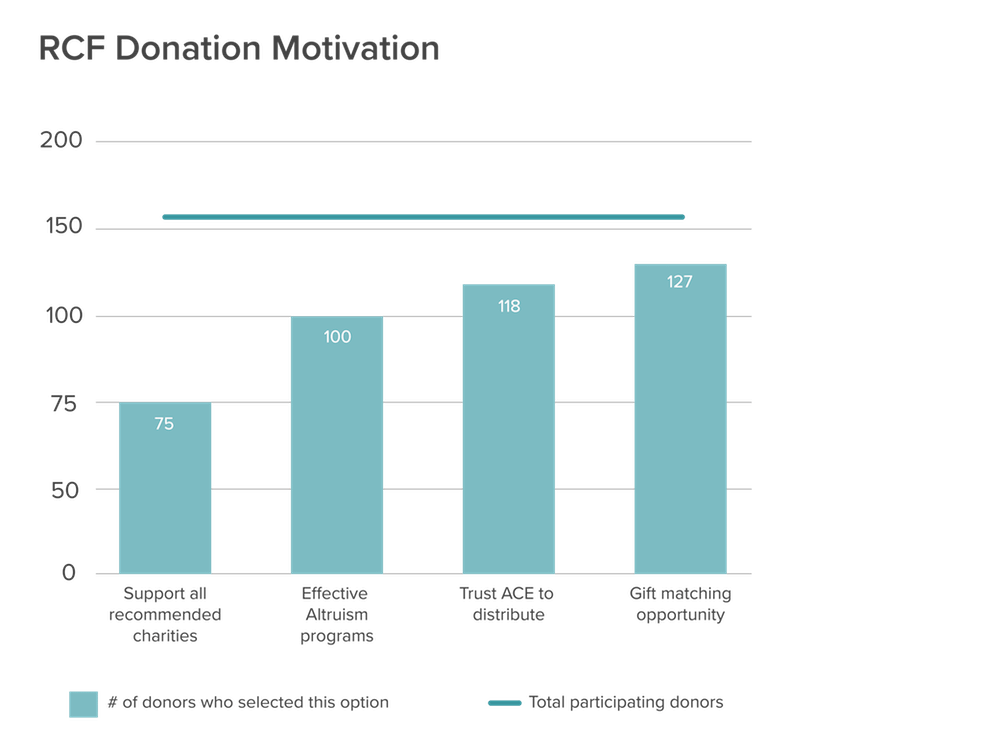
Of the 155 donors (or 36%) who participated in the survey:7
- 82% selected ‘The opportunity to have my gift matched’
- 76% selected ‘I trust ACE to direct my donation effectively’
- 65% selected ‘I want to support Effective Altruism programs’
- 48% selected ‘I want to support all of ACE’s recommended charities’
While only about one third of donors participated in the survey, we can see that the opportunity to have their donation matched was the leading motivator for these donors. Seeing that people are comfortable with having ACE redistribute their donation is also valuable information for us, as this gave us the confidence to open up this Fund for year-round donations following the campaign. Had people only donated because of the match, then we would have considered making this a one-time Fund. We were also interested to see that the opportunity to donate to all of ACE’s recommended charities was not a motivator for the majority of survey respondents, which indicates that we don’t necessarily need to distribute grants from this Fund to all of our recommended charities.
Animal Charity Evaluators
Last year, we spent $625,969 on ACE’s programs and operations and influenced $6,097,746 to highly impactful animal charities. This means that for every $1 ACE spent on our own programs in 2017, we influenced $9.70 to an effective animal advocacy charity. We have maintained this approximate 1:9 ratio for the past three years, even while experiencing significant growth.
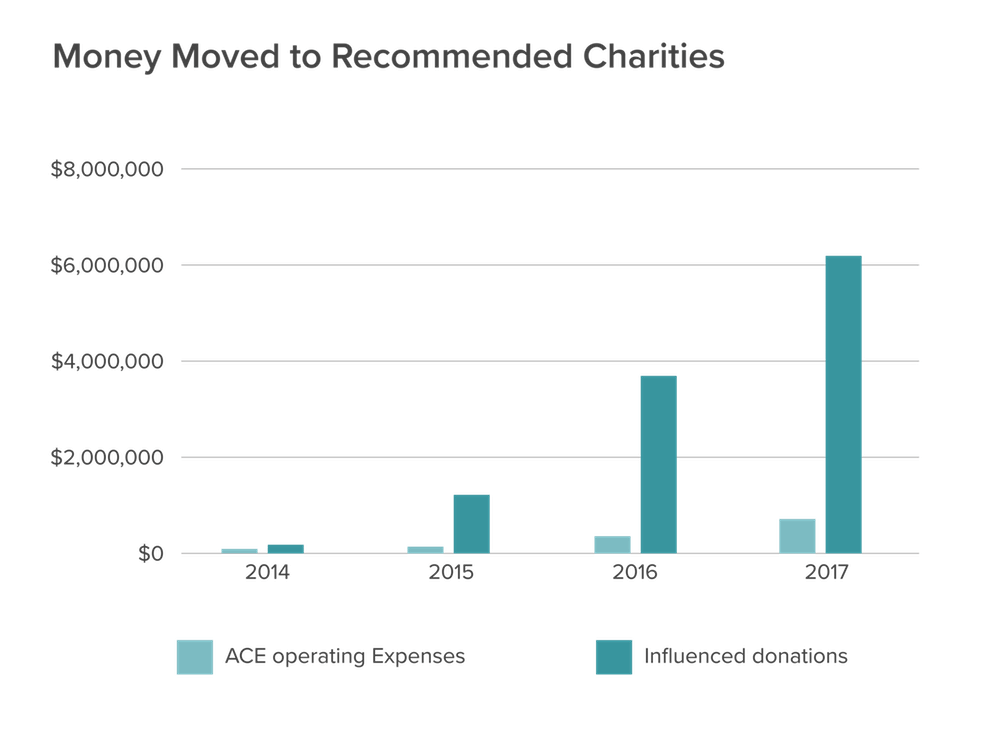
Donations to ACE
We have seen donations to support ACE’s programs grow steadily over the past four years, nearly doubling each year.8 We also grew our staff size from four people in 2014 to 15 people at the end of 2017.
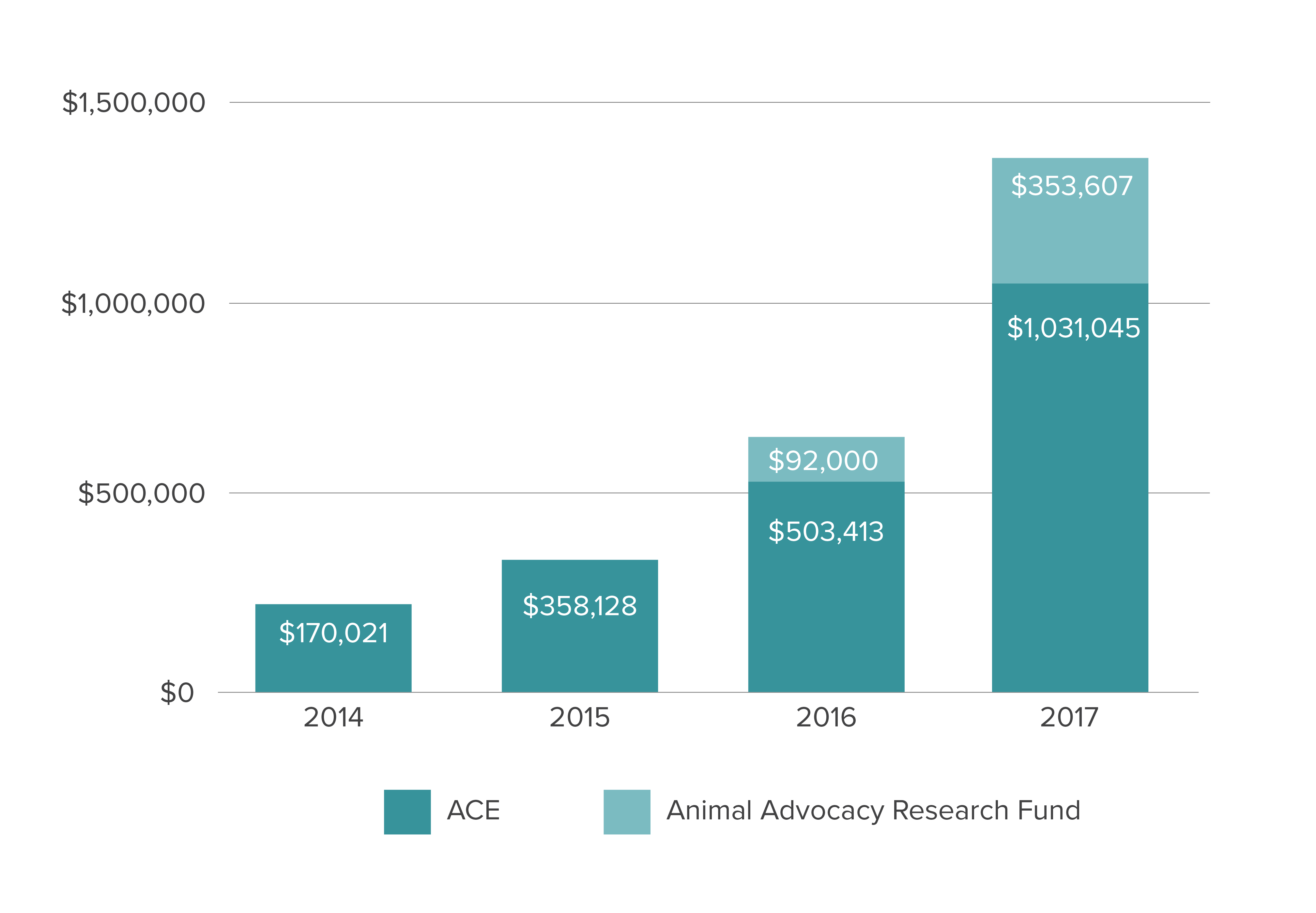
Excluding donations to the Animal Advocacy Research Fund, the average gift to support ACE’s programs and operations in 2017 was $687 and the average total annual donation per person was a very generous $2,322.
| Giving Category* | Number of Donors | % of Total Donors | Amount Donated** | % of Total Amount |
| $100,000-$1,000,000 | 3 | 0.7% | $686,000.00 | 66.3% |
| $50,000-$99,999 | 2 | 0.5% | $102,807.35 | 9.9% |
| $10,000-$49,999 | 12 | 2.7% | $177,500.68 | 17.2% |
| $5,000-$9,999 | 3 | 0.7% | $20,000.00 | 1.9% |
| $1,000-$4,999 | 12 | 2.8% | $19,785.00 | 1.9% |
| $500-$999 | 16 | 3.7% | $10,684.26 | 1.0% |
| $100-$499 | 61 | 14.1% | $11,312.44 | 1.1% |
| $0.50-$99 | 324 | 74.8% | $7,175.08 | 0.7% |
| * Giving categories are based on a donor’s annual total donations to ACE (excludes donations to support the Animal Advocacy Research Fund).
**Total revenue differs from the “Amount Donated” total due to revenue from investment gains, research workshop ticket sales, and third-party revenue sources such as Amazon Smile which cannot be attributed to an individual donor. |
||||
Two-thirds of donations to ACE in 2017 came from three donors who gave over $100,000 throughout the course of the year. This is a fairly dramatic shift compared to 2016, and was due to the following factors:
- We received our first grant from the Open Philanthropy Project for $250,000 in 2017.
- The donor who funded our 2016 year-end uncapped matching challenge made their matching donation to ACE in January of 2017 (after the campaign ended on December 31, 2016).
- We received an unexpected gift from a donor in October, which—with the support of a handful of other donors in the following months—allowed us to meet our annual fundraising cap and stop raising funds for ACE, shifting the focus of our entire year-end campaign to raise funds for our recommended charities.
To further expound on point C, in 2017 ACE experimented with setting a fundraising cap for ourselves. We determined the amount of funds that we felt ACE could use effectively within the coming months, and we decided that we would not accept more donations than necessary. We wanted to make sure that any additional money beyond what we needed would support the high-impact animal charities that we recommend. Thanks to the generosity of one of our three top donors, who donated one-fifth of our budget for the year, we came unexpectedly very close to meeting this cap. With further support from a handful of our most dedicated supporters, we were able to meet our own funding needs for the year by November. This allowed us to run a year-end fundraising campaign that raised $1.26 million for our Recommended Charity Fund—significantly more than the $511,290 that we raised during ACE’s 2016 year-end matching challenge.
In 2016, we received 46% of our annual revenue in November and December.9 Because we did not fundraise at all for ACE during the busy 2017 giving season—when historically over half of ACE’s supporters donate—we saw a dramatic decrease in the percentage of donors who gave less than $10,000 to ACE compared to 2016. This allowed donors who may have donated to ACE at the end of the year to instead direct their giving to our recommended charities. While this left us with a smaller proportion of funding from small individual donors than we typically have, it ultimately resulted in greater efficiency. Every dollar that came through ACE in 2017 had a greater impact, since we spent less time fundraising for our own organization.
Related Metrics
Web Traffic
We monitor the number of users who visit our website, but we pay particular attention to the number of unique new users who visit the ACE website via organic search in order to help us track the growth of our audience. We also feel that this is a probable indirect measure of growth in the effective animal advocacy movement as a whole. Although we do receive a number of visitors as a result of advertising—Google AdWords or social media—we feel that tracking the number of people who visit our website after conducting a simple search gives us a more accurate indication of movement building.
The chart below shows the total number of unique monthly new users to the ACE website from January 2017 through December 2017 that resulted from organic searches, (not from social media or paid advertising).10
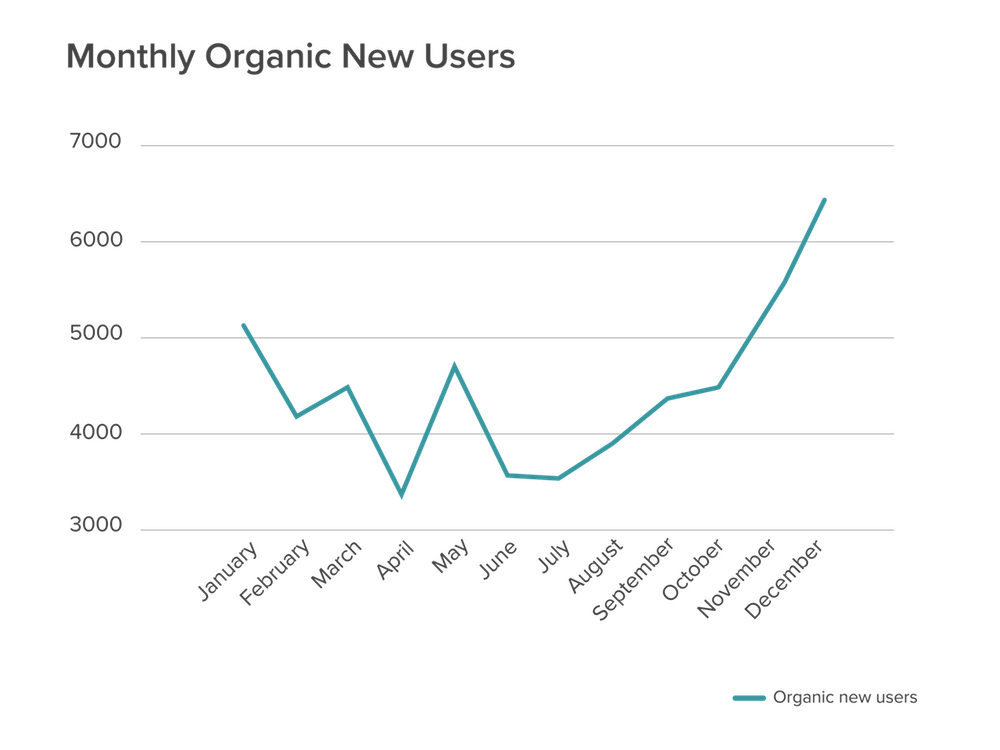
In January 2017, the number of unique monthly new users was 5,116 and in December 2017 the number was 6,422. This means that organic web traffic grew by 25% over the last year. Average total monthly user traffic in 2017 (including social, paid advertising, referral, email, and direct traffic) is approximately 28,500 each month.
Animal Advocacy Research Fund
In Spring of 2016 we launched the Animal Advocacy Research Fund as part of our plan to expand quality research in the animal advocacy movement. The Fund and its Program Officer are funded entirely by an anonymous donor who is also committed to developing high-quality research. This benefactor has committed to providing $1 million in funding to the Fund over a three-year period. In 2017, this accounted for $353,606.55 of our revenue. No general donations to ACE have gone to support this program.
To see a complete list of funded projects, visit the Animal Advocacy Research Fund website.
Donor Survey Results
One of our main goals is to bring more attention to issues such as cause prioritization and effectiveness, while also giving donors the opportunity to learn about charities they may not have previously considered. This is a significant aspect of our research and outreach programs. To better understand how we are educating and influencing philanthropists, we conduct an annual survey of ACE donors and Top Charity donors who report that their donations were influenced by our recommendation. Our 2017 survey was sent in October and November to donors who had made donations to ACE, Mercy For Animals, The Good Food Institute, and/or The Humane League since our 2016 ACE and Top Charity donor surveys were conducted a year prior.
Trends we look for in our annual donor survey:
- Convincing donors who prioritize effectiveness (but had not previously considered animal welfare to be a priority) to care about reducing animal suffering
- Convincing general animal welfare donors to care about farmed animal suffering
While we value our role as a resource for longstanding animal charity donors who want to ensure that their gifts are being used to do the most possible good, we know that one important way to expand our impact as a meta-charity is to influence new philanthropic dollars to highly effective charities.
With this in mind, there were some key takeaways from our 2017 donor survey.11
Respondents generally indicated ACE’s positive influence on their donation process.
- 87.9% reported that they used ACE’s recommendations to guide their donations in the previous twelve months.
- Donors increased their annual donations by an average of $2,120 because of ACE’s charity recommendations.12
- Many respondents reported that ACE “strongly” or “very strongly” influenced their decision to donate to each charity.
- 89.3% of GFI donors indicated that ACE “strongly” or “very strongly” influenced their decision.
- 83.5% of THL donors indicated that ACE “strongly” or “very strongly” influenced their decision.
- 80.4% of MFA donors indicated that ACE “strongly” or “very strongly” influenced their decision.
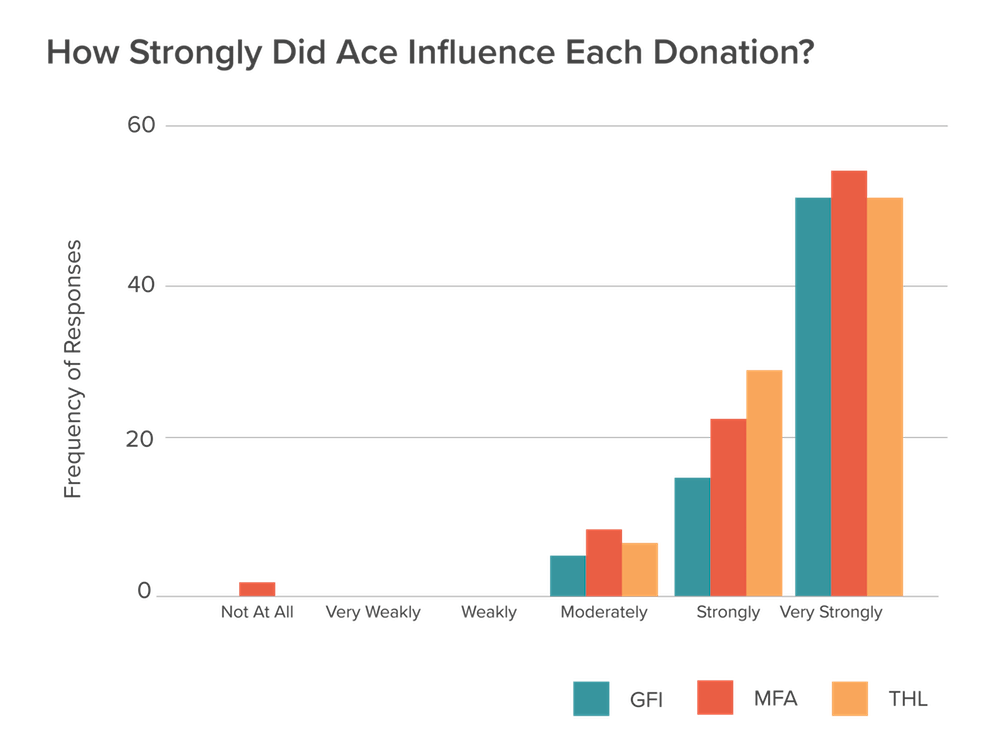
Donors to ACE and ACE Top Charities are heavily influenced by the principles of effective altruism (EA)
- A majority of respondents (60.5%) reported identifying as effective altruists. 19.1% reported not identifying as effective altruists, and 20.4% did not respond to the question.
- The EA movement was the most common way that donors reported learning about ACE. 43.3% of respondents reported learning about ACE through EA.
- Individuals who donated $1,000 or more to ACE and our Top Charities were more likely (76%) than smaller donors (60%) to identify as effective altruists.
ACE seems to divert some funds to farmed animal advocacy from other causes.
- 31.2% of respondents indicated that 2017 was the first year they donated to any animal charity (not limited to ACE and our recommended charities).
- On a question allowing for multiple responses, only 29.3% of respondents indicated that they would have donated to farmed animal advocacy charities in the past year without ACE’s influence.
- 13.4% of respondents indicated that, without ACE’s influence, the money they donated to ACE and our Top Charities would not likely have gone to any charity. That is, they would have used their donation money for personal spending and/or savings, and/or they weren’t sure how they would have used it.
- Additionally (and non-exhaustively), respondents indicated that, without ACE’s influence, they would have used their donations for the following (alone or with other responses):
- Other EA-aligned charities: 38.2%
- Other animal charities: 35.7%
- Other charities: 20.4%
Additionally, we provide an optional survey to our Top Charity donors through the ACE website. After they make a donation to a Top Charity, they are asked, “Which issues matter most to you?” and offered five randomly sorted options.13) Since we started this survey in August 2016, 664 individual donors submitted survey responses, often choosing multiple options.
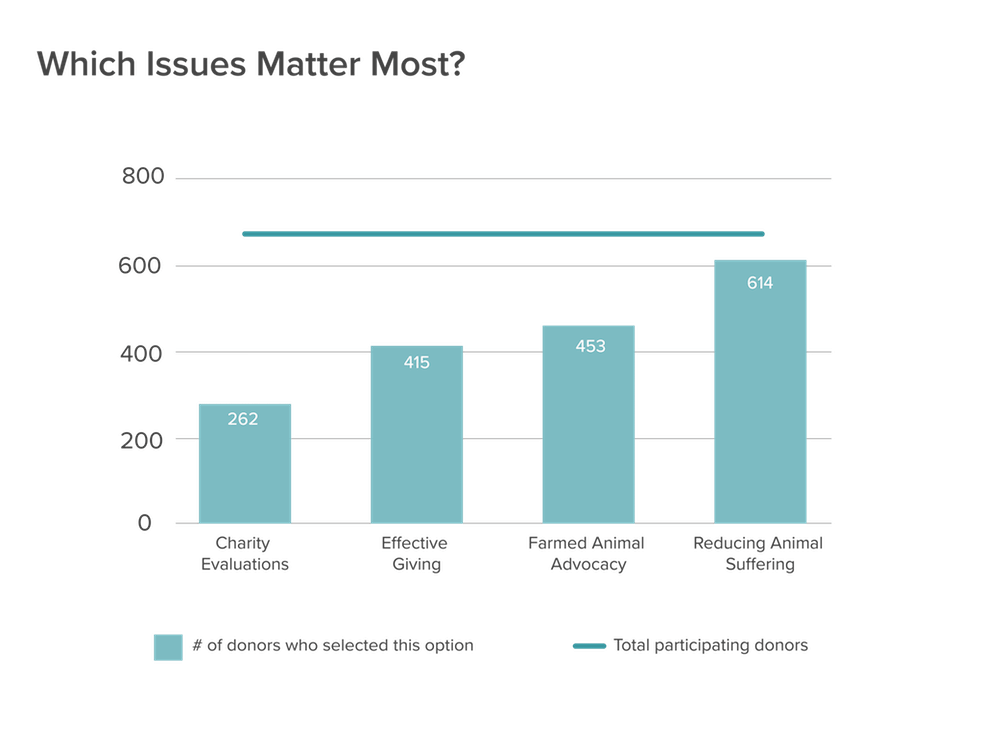
Of the 664 donors who have participated in the survey:14
- 92% selected Reducing Animal Suffering (up 2% from last year)
- 68% selected Farmed Animal Advocacy (down 3% from last year)
- 63% selected Effective Giving (up 5% from last year)
- 39% selected Charity Evaluations (up 1 % from last year)
From this survey, it is clear that the vast majority of people who donate to our Top Charities through ACE’s website are motivated by reducing animal suffering, while a much smaller group are motivated by our charity evaluations. What is interesting is the small but noticeable increasing interest in effective giving, mirroring the general philanthropic shift toward impact-driven philanthropy versus more traditional emotionally-driven philanthropy.15 This change indicates that the effectiveness of each dollar given to a charity is nearly as important as knowing what sort of advocacy that charity will conduct with each dollar, for example by helping farmed animals.
ACE’s Impact
In 2017 we held our largest fundraising campaign to date, and we were very impressed by the results. Donors gave more than double our initial goal for the campaign. The success of this campaign, coupled with the influx of new donors, highlights that people are eager to maximize their impact but are inclined to outsource the decision making on how to go about doing so.
Our donor survey results support this theory, with nearly 88% of respondents (who identified primarily as effective altruists) reporting that they used ACE’s recommendations to guide their donations in the previous year. This is similar to our 2016 results, which showed that 78–91% of respondents were very strongly influenced by ACE to donate to our Top Charities. We also heard from donors that they gave more money to effective animal charities as a result of our charity recommendations.
Effective giving is an increasing interest of philanthropists in general, and we are seeing that mirrored in our giving trends. More of our Top Charity survey respondents are indicating that “effective giving” is one of the issues that matter most to them. Additionally, the growth in organic traffic to our website suggests that people are increasingly interested in identifying effective charities.
Perhaps most important is that ACE continues to influence very generous donors to our recommended charities. The $764 average gift to recommended charities is substantially higher than the sector average of $93.16 We also saw donations from the group of donors who give at the $1–$99 level jump up to the $100–$499 level indicating that people are either giving more generously to effective animal charities, or they are diverting more of their philanthropic resources to effective charities. Donors to our newly launched Recommended Charity Fund were even more generous, giving nearly double our normal average gift to recommended charities.
Donations that we know to be influenced by ACE continue to make up a significant percentage of our Top Charities’ annual revenue.17 In 2017, donations that were influenced by ACE made up at least 7% of Mercy For Animals’ revenue, 16% of The Humane League’s revenue, 22% of The Good Food Institute’s revenue, and 12% of Animal Equality’s revenue. All of this indicates that we are making progress in our mission to help highly effective charities expand their programs by directing engaged donors and critical funding their way.
Reflecting on 2016 Goals
2016 Lesson 1: Diversify ACE’s donor giving categories so that we are less dependent on the top percentage of donors. In 2017 we saw even heavier reliance on a few significant donors, with two-thirds of our revenue coming from just three donors. The reasons for this shift are outlined in “Donations to ACE.” While there was a reasonable explanation for our failure to meet this goal—which ultimately allowed us to provide the greatest support to our recommended charities to date—our long-term goal is still to establish a more sustainable balance in our revenue without relying too heavily on any one funder.
2016 Lesson 2: The donors that ACE engages give generously and strategically. In 2017 we saw the average gift to Top Charities decrease, but the number of donors increased. The average donor gave nearly $1,420 to our Top Charities over the course of 2017, with an average individual gift of $555—meaning that these donors are giving frequently and generously. It is the frequency and generosity that remain clear indicators that the philanthropists who are engaging with our research and recommendations are committed to increasing their impact. Even though we worked with an increasing number of philanthropists in 2017, we saw the strength and commitment from these individuals continue.
2016 Lesson 3: Improve upon the way we track donations that were influenced by ACE’s research. In 2017 we developed a clearer outline of how our Top and Standout Charities can support this effort to track our impact in this way, and encouraged them at the start of the year to be more proactive about understanding a donor’s motivation for giving. This resulted in increased reporting from most of our recommended charities. We also developed a donation report form for our website so that donors could report their own donations that were influenced by ACE, and we were very fortunate to see a number of donors who were happy to share their 2017 donations to help us better track our impact.
2016 Lesson 4: Update the annual donor survey to better understand a donor’s history of donating to animal charities. Our 2017 donor survey included a question asking donors if this was the first year that they had donated to an animal charity (not just an ACE Top Charity). 31.2% of respondents indicated that 2017 was the first year they donated to any animal charity. This metric is important to us because it represents donations that ACE may have influenced to help animals that otherwise might have gone to other causes.
2016 Lesson 5: Increase percentage of influenced donations that support our Standout Charities. In 2016, 25% of ACE-influenced gifts went to Standout Charities, and in reality almost all of that 25% went to one Standout Charity (Humane Society of the United States’ Farm Animal Protection). In 2017, we increased our promotion of our Standout Charities, improved upon our donation tracking system that resulted in more ACE-influenced gifts being reported, and developed the Recommended Charity Fund that supported our Standout Charities, resulting in an increase to 39%. We think that this ratio is significantly more sustainable and better supportive of the important work of all of our recommended charities.
Lessons from 2017
Lesson 1: Donors are motivated by matching challenge campaigns. The 2017 year-end matching fundraising campaign for our Recommended Charity Fund was a resounding success. It genuinely surprised us and the matching donor. Given that there were dually important elements to this campaign, it’s difficult to identify the strength of this motivator over the other (below). Regardless, despite the skepticism about matching campaigns (which we have addressed here), it is clearly a strong motivator for some donors.18 We should attempt to offer more of these campaigns, if we are lucky enough to continue to have donors who offer to provide non-illusory matching challenges.
Lesson 2: Donors are attracted to the opportunity to outsource their donations. The other potential motivator for the year-end campaign was the launch of the Recommended Charity Fund. This was ACE’s first foray into collecting and distributing donations on behalf of donors, and we heard from a large number of donors who were happy to make a single gift that would be distributed to highly effective animal charities according to their funding needs. While it is impossible to know the exact role that each motivating element played in the resulting success of this new Fund during the year-end campaign, we can continue to monitor the strength of this motivator by charting the growth of this Fund when it does not have an accompanying matching challenge.
Lesson 3: Better calculations produce better results. We improved upon the way we calculate the number of donors influenced by ACE, which resulted in a smaller increase in the number of influenced donors from 2016 to 2017, but a more accurate representation of our impact. This year, we compared donors across all recommended charities and to the Recommended Charity Fund, and calculated that we had influenced 1,915 people to give to effective animal charities. Now that we have a more accurate way of calculating this information, we will be able to better track our growing influence.
You can read our 2016 Giving Metrics Report here.
To avoid counting a gift twice, we compare our internal list of reported gifts to the list provided by the charities. If there is any question about a possible duplicate gift, then we review those gifts with the charity to confirm if these were additional gifts or the same gifts.
Some charities provide us with donor names (but no other private or identifiable information) so that we can compare these donors’ gifts across all ACE recommended charities that they may have supported. Other charities provide us only with donor identification numbers, which means that we are unable to confirm if those donors gave any gifts to other ACE recommended charities. Because of this, we cannot say definitively that we influenced 1,915 donors in total. However, given the likelihood that many donors do not report or identify donations that were influenced by ACE, we suspect that the number of donors who use ACE’s recommendations as a consideration for their annual donations is significantly higher than what we are able to identify through our annual gift reporting process.
We did not count matching donations toward our own matching campaign. One $2,000 corporate matching gift and the $12,020 donation from the Gates Foundation/Facebook for their Giving Tuesday campaign were not matched by our matching donor.
Lifetime value is calculated by dividing the average annual donation by the attrition rate. In this case, we divided the average annual donation between 2016 and 2017 ($3,264.90) by our attrition rate between 2016 and 2017 (35%) and calculated an estimated lifetime value per donor of $9,328.28.
In February 2018, The Humane Society of the United States’ Farm Animal Protection Campaign was removed as a recommended charity due to significant concerns about their organizational culture. Further details are available on our website.
Respondents were allowed to pick multiple options, so the total will not add up to 100%.
It is possible that donations to ACE may have more-than doubled in 2017, had we not implemented our $1 million fundraising cap.
30% of our annual revenue came in December, which is consistent with the nonprofit sector overall—where 30% of annual giving occurs in December.
Traffic on the ACE website usually spikes during the giving season at the end/beginning of each year. In 2017, we also had a spike mid-year after the Open Philanthropy Project awarded ACE a two-year $500,000 grant.
This survey had 157 responses: 122 full responses and 35 partial responses. The survey was voluntary and likely had a response rate of between 12% and 23%. Thus, it may not be representative of all donors who were influenced by ACE.
We excluded nonrespondents from this estimate and used the arithmetic mean of each response range in our calculation.
The fifth option, “Other” with a custom text box, is excluded from this chart since we do not track the number of “Other” responses. (Each donor provides a different response, making this data point inconsistent.
Respondents were allowed to pick multiple options, so the total will not add up to 100%.
https://www.fidelitycharitable.org/docs/future-of-philanthropy.pdf, page 9.
According to DonorTrends, the 2016 average gift for the animal-related sector was $93, an increase of $10 over 2015.
$934,290 of Mercy For Animals’ 2017 reported $13,225,596 revenue, $1,442,375 of The Humane League’s 2017 reported $6,825,478 revenue, $1,062,002 of The Good Food Institute’s 2017 reported $4,687,032 revenue, and $674,504 of Animal Equality’s 2017 reported $5,562,550 international revenue.
For further empirical evidence on the positive effects of matching challenge campaigns, please see Eckel and Grossman, 2007, Eckel and Grossman, 2008, Karlan and List, 2007, Karlan, List, and Shafir, 2011, Meier, 2007, and Rondeau and List, 2008.